SpaceX launches 105 small satellites into orbit, nails rocket landing
CAPE CANAVERAL, Fla. — SpaceX successfully launched its second rocket of the year Thursday morning (Jan. 13) as one of its veteran boosters carried 105 small satellites into orbit before landing back on Earth.
The two-stage Falcon 9 rocket lifted off into a clear blue sky at 10:25 a.m. EST (1525 GMT) from Space Launch Complex 40 at Cape Canaveral Space Force Station here in Florida, carrying dozens of small satellites.
Approximately nine minutes after the rocket leapt off its launch pad, the first stage returned to the Cape, touching down on a landing pad just miles away from where it launched.
"Stage 1 landing is confirmed," SpaceX officials called out on the launch broadcast.
"As you heard, the Falcon 9 has landed for the 10th time," SpaceX reliability engineering manager Kate Tice said in the broadcast. "This marks our 102nd overall recovery."
Related: Watch a SpaceX rocket ace landing on a drone ship in stunning new video
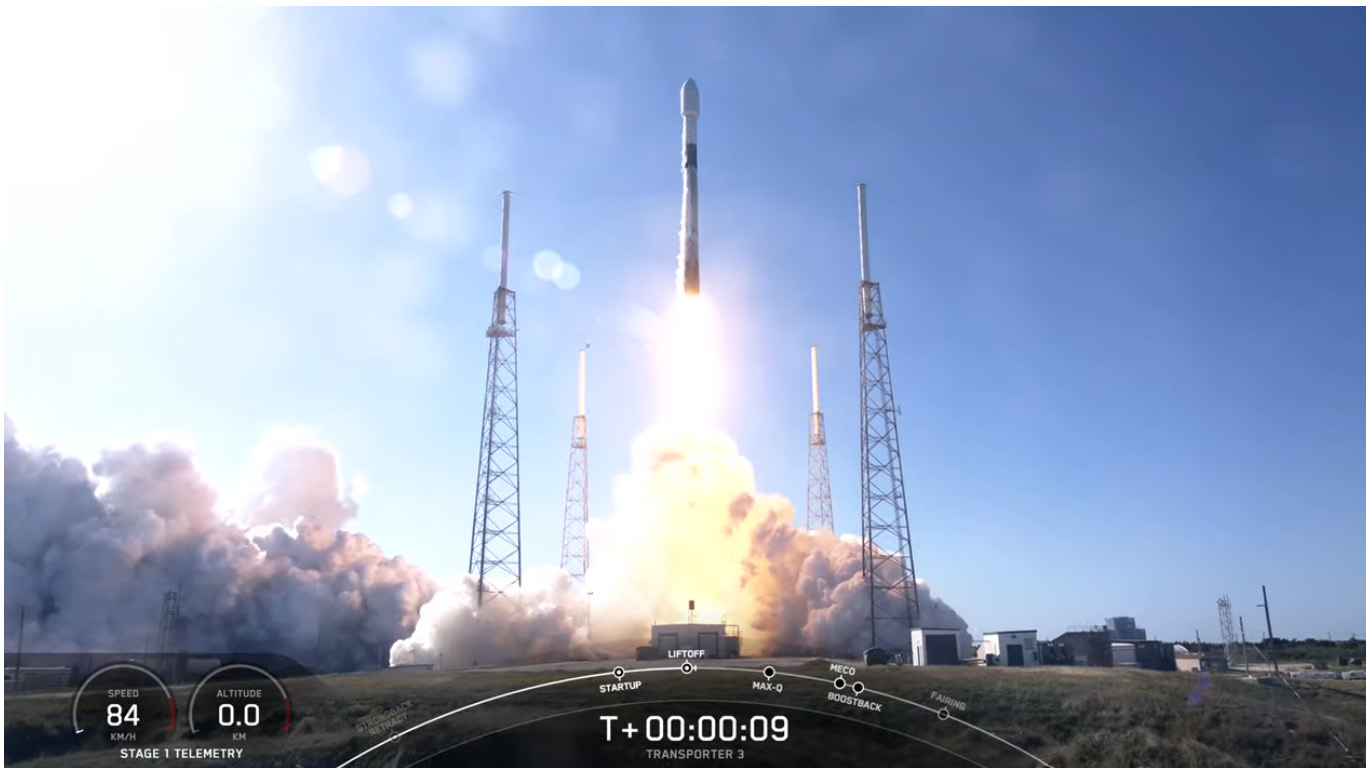
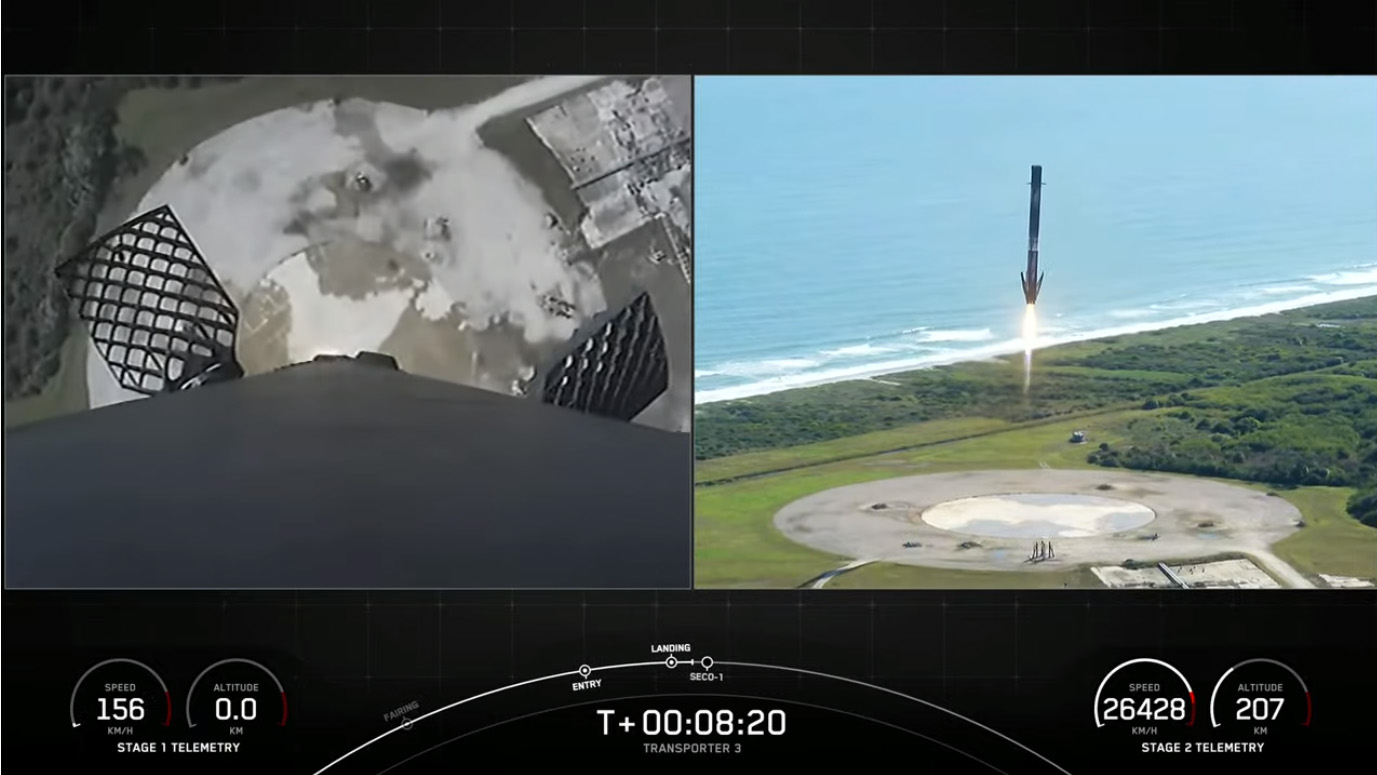
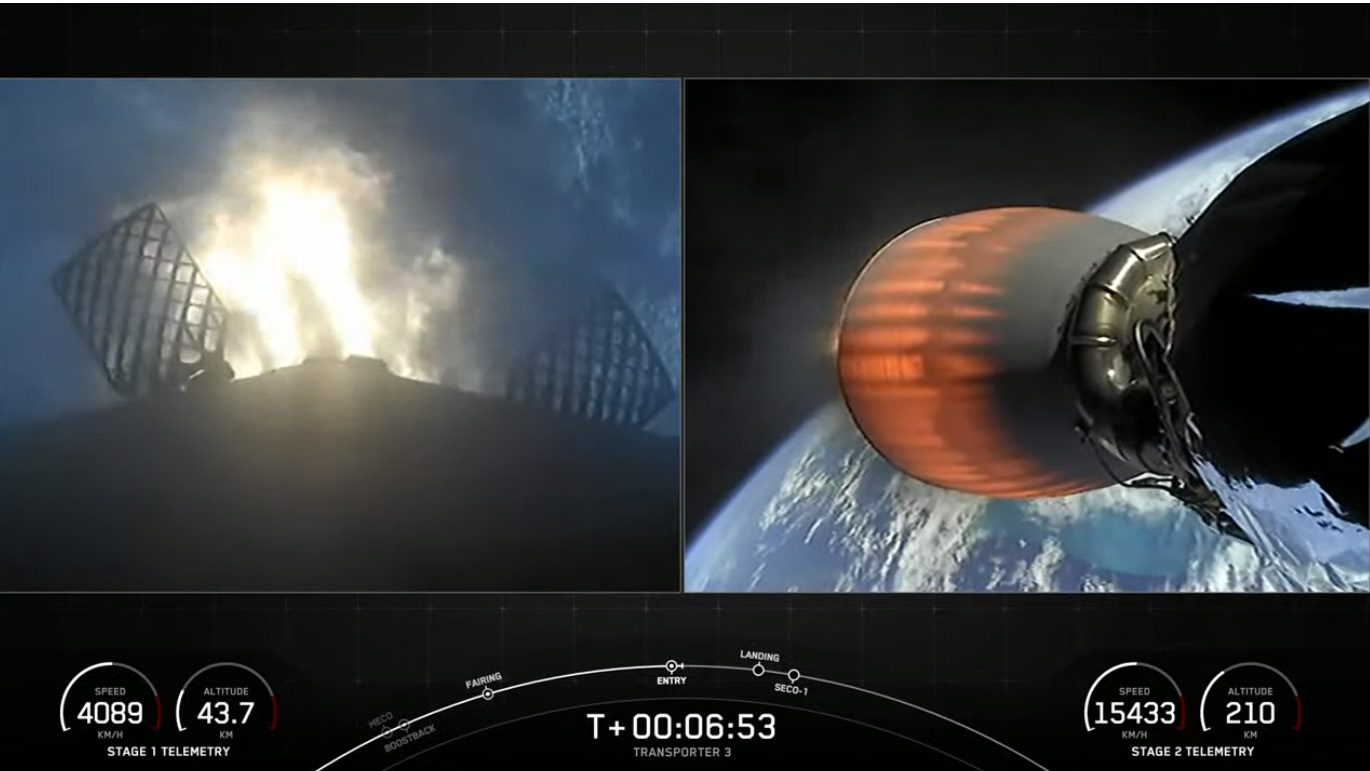
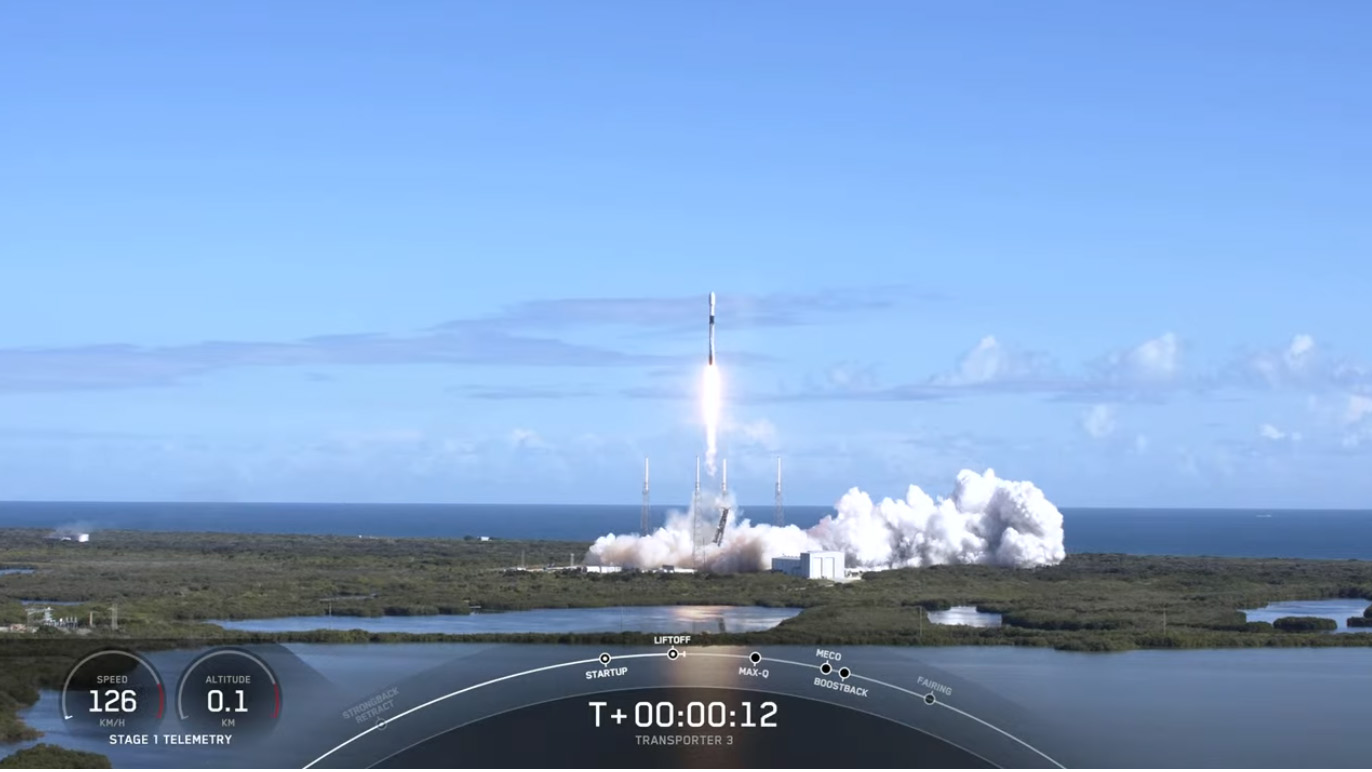
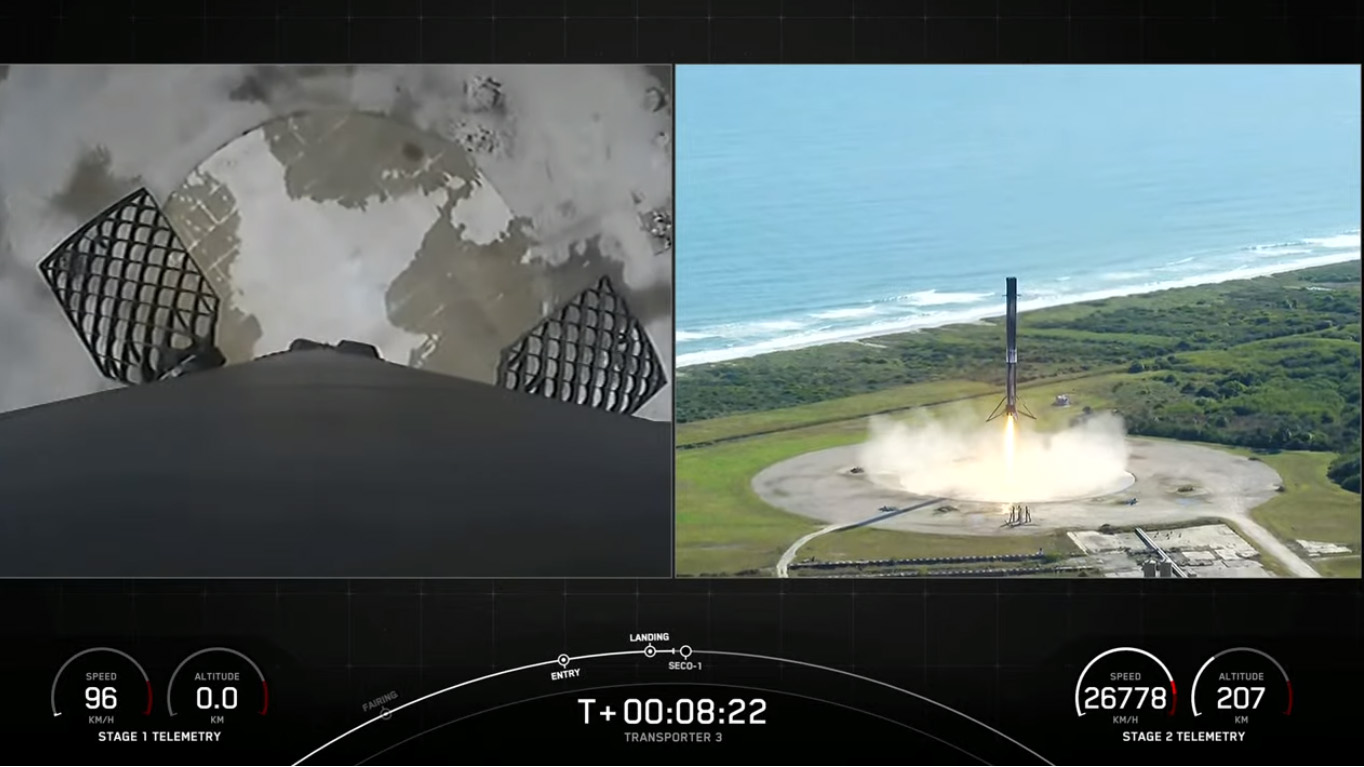
The mission, called Transporter-3, was SpaceX's third dedicated rideshare mission. It was expected to disperse 105 small satellites into polar orbit, which sees satellites circle Earth above its poles, in a series of deployments that began an hour after launch.. This orbit is sought-after by Earth-observation companies as it conveniently allows the orbiting satellites to scan the entire planet on a daily basis.
Get the Space.com Newsletter
Breaking space news, the latest updates on rocket launches, skywatching events and more!
The launch marked the second mission of 2022 for SpaceX and the company's second within a month from Florida's Space Coast. (SpaceX has more launches on the books for this month, keeping up with the rapid launch cadence it set last year.)
Today's mission marked the 10th successful flight and landing of a first-stage booster with a designation B1058, which first entered service in May 2020 when it launched two NASA astronauts — Bob Behnken and Doug Hurley — to the International Space Station (ISS) as part of the Demo-2 Crew Dragon mission.
Following that flight, the booster has carried five different groups of SpaceX's own Starlink internet satellites to orbit, helping to build out the company's burgeoning megaconstellation. It also ferried the Transporter-1 mission last January (SpaceX’s first dedicated rideshare endeavor) and launched a cargo Dragon capsule to the space station in December 2020.
SpaceX first announced its rideshare program in 2019, offering small satellite operators an opportunity to launch their spacecraft for a combined price of $1 million per launch. So far, the company has been aiming to launch two Transporter missions per year but the success of the program has led to suggestions that the launch-rate could be doubled.
Related: See the evolution of SpaceX's rockets in pictures
All aboard the Transporter-3
The Transporter-3 rideshare mission was facilitated by companies like Spaceflight Inc., and Exolaunch, which help small satellites customers book their perfect ride to space.
These types of missions work much like an established bus route, when companies see an opportunity to get to space, they book it and go. Transporter missions are ideal for those payloads that do not need to go to a specific point in space, but more of a generalized area.
"The Transporter mission concept is unique," Derek Tournear, director of the Space Development Agency (SDA) — a government agency which supports space development in the interest of national security — told Space.com. "If you're orbit agnostic, this is a perfect service."
"You don't have to wait a long time for launches, you just book the flight when you're ready and go."
Historically, smaller satellites have had very limited options on how to reach space, with the majority of them squeezing in on missions with larger satellites, hoping there's a bit of extra space in the payload fairing. But as launch costs decrease, and more and more launch vehicles take to the skies, these minuscule space fliers now have options. They can choose to pack into a rideshare mission or even fly on their own, depending on size and orbital constraints.
SpaceX is just one of many launch providers offering these types of options. Rocket Lab and Virgin Orbit are other providers as well, having launched multiple small satellite payloads into space.
Exolaunch, a company that helps broker rides on missions like these and one of the passengers on Transporter-3, is launching a satellite for NuSpace, a start-up out of Singapore.
"NuSpace is our first customer from Singapore and we’re very pleased to extend our presence in this region," Jeanne Medvedeva, VP Launch at Exolaunch said in a press release. "Impressed by what the team of NuSpace has achieved so far, we’re proud to have provided a one-stop launch solution within a very short timeframe under the SpaceX’s Rideshare Program and to have successfully integrated NuX-1 with Falcon 9 for launch later this month."
To date, Exolaunch has arranged launches for 170 satellites for a variety of customers including start-ups, space agencies, and scientific institutions. Thanks to a multi-launch agreement with SpaceX, the company deployed 59 small satellites last year between SpaceX's first two Transporter missions.
For its third act, Exolaunch is set to deploy 29 more satellites from 17 countries, its most diverse payload yet, according to company representatives.
In the case of the rideshare option, it may be easy to book the ride, but launching dozens of tiny satellites at one time is no easy feat. The deployment sequence is carefully timed, with each satellite releasing at just the right time, minimizing the risk of collisions. Specialized launch dispensers and transfer stages are also used to stagger satellite release.
D-Orbit, an Italian launch broker, is just one of a few brokers that have its own free-flying transfer stage. Called ION SCV004, the transfer stage will first deploy from the Falcon 9's upper stage before later depositing its own passengers into orbit.
Related: Russia says SpaceX Starlink satellite and space junk may narrowly miss Progress cargo ship in orbit
The 105 different satellites on-board the Transporter 3 mission come in a range of sizes from smaller than a soda can to shoebox-sized to the size of a washing machine.
The biggest of the group is the Ukrainian Sich 2-1 satellite, a 375-pound (170-kilogram) Earth-imaging satellite for the Ukrainian government. Built by a company called Yuzhnoye, the satellite has been delayed for years thanks to the country's political turmoil. It is designed to take pictures of Earth in order to help track environmental changes, urban sprawl and to help with crop management.
Also on board are a pair of satellites for both ICEYE of Finland and Capella Space of the U.S. These are just two companies of many who are trying to build a mini-constellation in low-Earth orbit. Their fleets of small satellites have similar functions: to monitor and map Earth's landmasses, oceans, and ice sheets through radar imaging.
This technique does not provide as much color or detail as optical remote sensing, but has an extra perk — radar can see through clouds and in the dark, which optical instruments cannot.
ICEYE's pair of satellites will join 13 others already in orbit, with each satellite weighing at around 187 pounds (85 kilograms). Capella's duo is roughly 220 pounds (100 kilograms) apiece and will join five others in space.
They were not the only radar-equipped satellites aboard the Transporter-3 mission. Umbra launched the second satellite of its burgeoning constellation that will be able to provide the highest-resolution commercial radar images from space. With a resolution of 6 inches (15 centimeters), Umbra's 143-pound (65-kilogram) spacecraft beats ICEYE's 3-feet resolution imagers.
On board of the mission were also 44 SuperDove satellites of Earth-imaging company, Planet, which strengthened the company's 240-strong fleet of optical Earth-observing satellites.
Other payloads of note were eight 'Tevel' CubeSats built by students in Israel to provide amateur radio communications in low-Earth orbit.
Spire Global launched five small satellites to join its current constellation, which will collect and monitor weather and ship-tracking data. Kepler Communications, a Canadian data relay company, had a quartet of cubesats on board that will join 15 others already in orbit.
South Africa launched a trio of satellites, called MDASats, which are part of a government effort to track and monitor maritime traffic.
It took approximately an hour-and-a-half for all the passengers to deploy from the upper stage. (Subsequent satellite deployments from the onboard free-flying transfer stages happened after that.)
Polar trajectory flight
The Transporter-3 mission flew along an unusual path that took it south, along the east coast of Florida and over the Atlantic Ocean so it could deposit its payload into the polar orbit. Typically, when rockets launch from Florida, they launch on an easterly path over the ocean.
We see these types of flights typically launch from the West Coast as they can more easily avoid populated areas. However, last summer, SpaceX was granted permission to launch flights bound for a polar orbit from Florida — a first since the 1960s.
The Transporter-3 mission was the fourth to follow this trajectory. (The first was the SAOCOM-1B mission, which launched an Earth-observing satellite for Argentina.)
Along with recovering the first stage booster, SpaceX will continue its efforts of recovering the clamshell-like hardware surrounding the stack of satellites, called the payload fairing (or rocket's nose cone). To that end, SpaceX has deployed one of its newest recovery vessels, named "Bob" after NASA astronaut Bob Behnken.
Follow Amy Thompson on Twitter @astrogingersnap. Follow us on Twitter @Spacedotcom or Facebook.
Join our Space Forums to keep talking space on the latest missions, night sky and more! And if you have a news tip, correction or comment, let us know at: community@space.com.

Amy Thompson is a Florida-based space and science journalist, who joined Space.com as a contributing writer in 2015. She's passionate about all things space and is a huge science and science-fiction geek. Star Wars is her favorite fandom, with that sassy little droid, R2D2 being her favorite. She studied science at the University of Florida, earning a degree in microbiology. Her work has also been published in Newsweek, VICE, Smithsonian, and many more. Now she chases rockets, writing about launches, commercial space, space station science, and everything in between.
